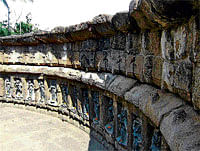Where gods and angels once descended

It has no towering shikaras or carved jagmohanas. But the vibrations resonating from it have powerful nuances and remain in my mind, long after I had visited it.
It also has no roof, this temple — it is open to the blue sky. It reminded me of some of the amphitheatres in Rome and Greece. There seems to be, according to a charming legend, even a connection between the open roof and the circular shape of the temple.
It is said that the yoginis or deities of the temple used to roam in the air, and when they descended, did so in a circle. The title — Chausat Yogini Temple — refers to the 64 yoginis, who are represented in chlorite in the niches of the temple’s circular walls.
According to Markandeya Purana, yoginis were asked to help goddess Durga in her battle against Raktabija, a demon, who had the horrific quality of multiplying from each drop of his blood shed on the ground. The yoginis, in their bid to help Durga, drank every drop of blood before it touched the ground, rendering him powerless, and got him killed.
In another account in Matsya Purana, an asura was terrorising the universe. Just like Raktabija, innumerable demons sprang up from his blood and then Siva attacked him. Then, Siva created several divine mothers who drank the blood and destroyed the demon. However, there was a corollary to this story. The divine mothers went on a rampage and Siva asked Narasimha to help create 32 more formidable mothers. Unable to battle these new mothers, the forms created by Siva went to Narasimha for help, whereupon he advised them to guard and nurture the universe.
These yoginis have their carved representations in the 64 niches set in the curved wall of the temple. Some have voluptuous bodies, some have horrific features, and some have animal heads. All have their mounts — mouse, goose, rat, lion — and the smooth black chlorite has been used to carve their beautiful bodies. Some manifestations are unusual, to say the least — Ganeshayini is in the form of Ganesha on her mount — the donkey, Kuberi complete with a prosperous stomach. In the centre is the presiding deity, the ten-armed Mahamaya. She was ornamented with a gold and red cloth.
On the exterior of the temple are the nava katyayinis. According to the Skanda Purana, these nine katyayinis are the different forms of the mother goddess. At the bottom of these figures, what is normally found is a severed head and a jackal or pig. They are usually devourers of carcasses and the figures have some kind of blade over their heads. The other figures include bhairavas too. Although the figures seem threatening and frightening, the sheer beauty of the forms annihilates that feeling.
In front of the temple is an oblong platform. I wondered why it was there. Was it made to host performances? The guide told us that tantric practices were sometimes observed here and I could imagine dancers performing in this space under starlit skies. I saw many widows, donning saris in sombre colours, prostrating themselves here. I left the temple with many unanswered questions. Who actually built this? Who was worshipped here? I am still looking for answers.